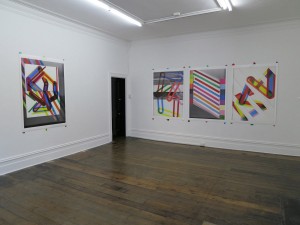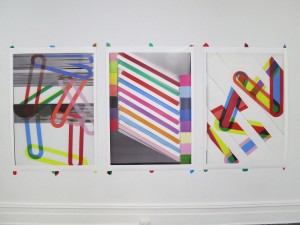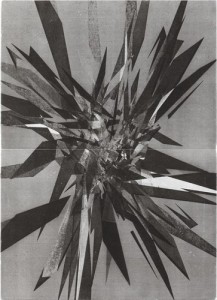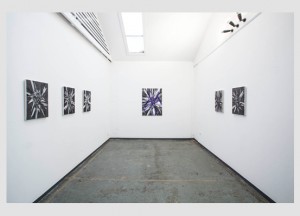Bryan Spier makes narrative abstraction. If this sounds like a contradiction in terms, it just might be. But it’s the kind of contradiction that allows an artist to work in an impossible space and make something of it.
My understanding of what Spier means by narrative abstraction is relatively straightforward. Take his new exhibition of large-format giclée prints, Heavy images, currently showing at Sarah Scout Presents. In each work objects or planes are frozen yet their frame-based logic communicates a certain movement, a kind of sequential disruption that opens each composition. This is meant to be evocative; as Spier puts it: ‘past and future iterations haunt them’.
In these works form becomes a kind of character, one that the mind can’t help but attach to certain feelings or motivations. What might have been a relatively mute and coldly formal exercise instead begins to layer itself in a very human way.
A similar current runs through Justin Andrews’s exhibition at Block Projects; a linear, human logic that kicks against abstraction’s alien nature. It’s worth mentioning that both artists went through the same art school, and are part of the Canberra diaspora that includes Stamm’s own Trev Clay and me. But there’s more to it than that. If you sit in a studio on a daily basis balancing forms and adjusting colours, it’d better have some kind of feeling.
Andrews thinks about time in this new body of work, which strikes me as a similar project to Spier’s. He focuses on the idea of entropy; the disintegration of an ‘original’ as it is copied, repeated or remembered through the prism of time passed. Andrews takes this disintegration as a positive, as if the new and uncontrollable things that occur in this process hold some kind of secret meaning.
A self-authored text included in the show suggests he is thinking about his own history, trying to link up various interests and motivations across time: painting, music, the grainy reproductions held between the covers of a discarded art book. Artists can’t arrest time, but they can at least try to make sense of it. Again, it’s a matter of feeling and thinking and doing, each of these activities following and prompting the other.
There’s a pattern of making across the art world at the moment that most people involved would recognise. It’s materially driven and it relies on increasingly ‘minor’ gestures that seem guided by a kind of post-sculptural ideology. Through this kind of work artists and, by extension, audiences are required to invest more in less. If you run with it, reduction and material repeatedly reveal sequences of minor revelations. Although people rarely seem to make the connection, all this is the stuff of good painting. It echoes in the suspended moments that Spier and Andrews both render.
Bryan Spier, Heavy images, Sarah Scout Presents, Melbourne, 1–31 August 2013.
Justin Andrews, Block Projects, Melbourne, 27 July – 17 August 2013.





